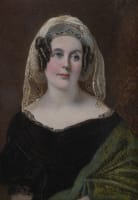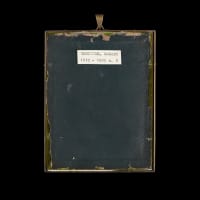Charlotte Hood, Baroness Bridport and Duchess of Bronte was the daughter of the Reverend William, first Earl Nelson (1757-1835) and his wife Sarah, née Yonge; and niece to Admiral Viscount Nelson (1758-1805) from whom her family would undeservedly derive wealth and titles. She was born in Norfolk where her socially ambitious father, like her grandfather the Rev. Edmund Nelson, languished as a rural curate. As a child, she had followed the astonishing rise to fame of her uncle Horatio attending the local balls and watching the fireworks which attended his great victory at the battle of the Nile in 1798.
When Nelson, now Baron Nelson of the Nile, returned to England in 1800 Charlotte’s parents shamelessly attached themselves to his mistress Emma, Lady Hamilton, happily ostracising Nelson’s wife Frances. Her manner had always antagonised the Nelsons despite Fanny’s obvious devotion for her niece which had included arranging her schooling in Chelsea and frequent holidays together. Instead, Charlotte was now...
Charlotte Hood, Baroness Bridport and Duchess of Bronte was the daughter of the Reverend William, first Earl Nelson (1757-1835) and his wife Sarah, née Yonge; and niece to Admiral Viscount Nelson (1758-1805) from whom her family would undeservedly derive wealth and titles. She was born in Norfolk where her socially ambitious father, like her grandfather the Rev. Edmund Nelson, languished as a rural curate. As a child, she had followed the astonishing rise to fame of her uncle Horatio attending the local balls and watching the fireworks which attended his great victory at the battle of the Nile in 1798.
When Nelson, now Baron Nelson of the Nile, returned to England in 1800 Charlotte’s parents shamelessly attached themselves to his mistress Emma, Lady Hamilton, happily ostracising Nelson’s wife Frances. Her manner had always antagonised the Nelsons despite Fanny’s obvious devotion for her niece which had included arranging her schooling in Chelsea and frequent holidays together. Instead, Charlotte was now placed in the noisy and unconventional household established by Nelson and Emma at Merton where she was haphazardly taught the social skills of singing, dancing and needlework. Sketches from this time show Emma and Charlotte affectionately playing piano and cards together. There was a sense of mutual exploitation in this arrangement with Charlotte’s parents, who constantly agitated for social preferment, seeking to ingratiate themselves with Nelson; whilst Emma wished to ally herself with the Nelsons against her lover’s estranged wife. Nevertheless, an obvious and genuine affection developed between Emma and her protégée, especially when Emma’s own daughter by Nelson was put into adoption to avoid scandal.
However, with the re-introduction to Merton of the infant Horatia as a ward, Emma’s relationship with Charlotte rapidly cooled before a fatal breach occurred after the battle of Trafalgar in 1805 when William Nelson received the honours, titles and money due to his dead brother. Charlotte was swiftly removed from Merton to tearful accusations of treachery by Emma whose former relationship with Nelson was now deeply uncomfortable and inconvenient to his family. She re-joined her parents, now Earl and Countess Nelson, becoming their sole heir when her brother Horace died in 1808. Charlotte attended Court and although her father harboured ambition of an aristocratic match, in 1810 she married Samuel Hood, scion of a famous naval family and, from 1814, second Baron Bridport. With the title came Cricket House in Somerset where the Bridports had seven children, six of them surviving childhood.
Despite his best efforts to father a son by a second marriage late in life, on Earl Nelson’s death in 1835 his English titles devolved to his nephew Thomas Bolton. However, as the earl could nominate his successor to the Sicilian dukedom of Bronte—bestowed on his brother by the King of Naples after the battle of the Nile—Charlotte duly succeeded as duchess causing a permanent breach in the descent of Nelson’s titles and triggering a series of bitter court battles over the fate of Nelson’s precious heirlooms most of which, including all his papers, were inherited by Charlotte. Despite being an intimate witness to the tumultuous last years of Nelson’s life before Trafalgar, and the longest surviving member of her family to recall the admiral, Charlotte guarded her privacy and she was rarely sought-out by biographers before her death in 1873.
Only in recent years, with the publication of major new biographies of Emma Hamilton has Charlotte’s pivotal role at Merton been re-assessed and its importance in the domestic life of Nelson been fully recognised.
This portrait is one of only two known surviving images of Charlotte Nelson, painted by Robert Thorburn, a favourite of Queen Victoria from the mid-1840s. Thorburn was a Scot, born in Dumfries where he trained at the Scottish Academy before moving to London in 1836. Thorburn was capable of producing portrait miniatures which rivalled their counterparts in oil – using large pieces of ivory and mixing his watercolour with gum to emulate the smooth richness of oil paint. This portrait would have been an early triumph for the artist, who portrays Charlotte in a deep black velvet gown and complex fabric turban – his talent for emulating such fabrics in paint already evident. Queen Victoria was impressed by his miniatures, noting ‘…such depth of colouring & such power as I have never before seen in a miniature’.[1]
[1] Journal of Queen Victoria, 23 February 1844 (online access via http://qvj.chadwyck.com/marketing.do)









